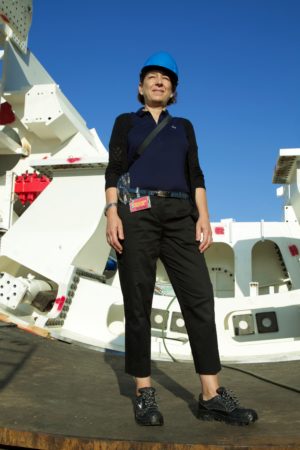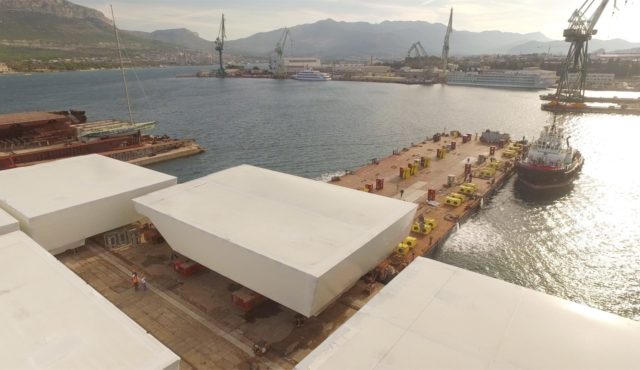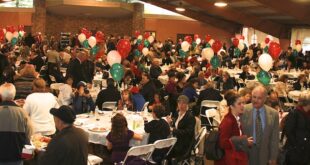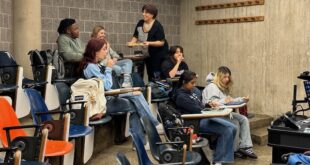 From the canals of Venice to the vineyards of Piedmont, Gia Marie grmella is hot on the trail of uncommon Italian stories.
From the canals of Venice to the vineyards of Piedmont, Gia Marie grmella is hot on the trail of uncommon Italian stories.
If you were to pick a current documentarian for the subject of a documentary, Gia Marie Amella would be a smart choice. Together with her partner, Giuseppe “Beppe” Mangione, she’s the force behind Modio Media, a production company that first came to the attention of the Italian-American community with the 2007 release of “And They Came to Chicago: The Italian American Legacy.” In the intervening decade, Amella has pursued an ambitious production schedule that’s equal parts frenetic and fantastic — and increasingly Italian in focus.
Amella’s most recent release is for the History Channel’s “Project Impossible” series. Unveiled this fall, her episode traces the construction of the MOSE flood control project, designed to beat back the rising waters of Venice. Before Amella started filming, the MOSE project was already awash with controversy: behind schedule, over-budget and the subject of corruption probes. The History Channel program focuses on the Herculean task of building and planting the monolithic “flapgates” designed to protect the La Serenissima.
She’s also working on “Wine Is Our Blood,” which traces the soaring demand for wine from, and land in, Piedmont’s Langhe hills region. It’s meant tremendous wealth for the local winemakers — an acre of land recently sold for $2.3 million — but has also created tremendous pressure to preserve family traditions that stretch back generations rather than to embrace generic business practices.
Meanwhile, Amella is tracing the 30,000-mile journey of the sole Italian mariner sailing in the Golden Globe Race — the adventurous Francesco Cappelletti, who helms the aptly-named 007. (Fra Noi, February 2018) Says one supporter: “When Francesco wants to accomplish something, not even God can stop him!”
Lou&A spoke with Amella about her current documentary work, her decision to put down roots in Italy, and what Italian culture meant to her as she found her calling in film.
Lou&A: Tell us about your Italian roots and upbringing.
Gia Marie Amella: My father’s family was Sicilian and came from the Agrigento province. On the other side, I’m a mutt, although it’s prominently French Canadian. But the Sicilian part was definitely the dominant culture for me growing up. I was born in Chicago and my parents were, too. My dad was an insurance agent and mom was an admin for my father most of my life. In 1976, Dad was looking for a change, so we put everything we had in a Ryder truck and moved to California: first San Jose, then Los Gatos, and eventually Santa Cruz. I went to UC Santa Cruz for my undergraduate degree in Italian literature.
L&A: How did you find your creative calling?
GMA: I had a creative bent from an early age. In 7th grade I was already taking advanced classes in composition and read voraciously — I read extremely early. I was the kid who brought encyclopedias to bed. [Laughs.] There was a big Italian community in Los Gatos, and I studied Italian when I was a freshman in high school. I loved literature. In college, I started working at the university newspaper called City on a Hill and had a bi-weekly show on the community school radio station. I was dabbling in media as an undergrad and also did a number of independent studies, including neorealism in film. I was really drawn to the great Italian films of the 1940s and 1950s.
L&A: Your career sounds like a mix of all those things.
GMA: There’s no question I love fiction film, but I’m so much more invested in real stories. If you look at my bookshelf, you’re going to find almost all non-fiction works. I extensively watch docs, and I’m fascinated by people. And the work Beppe and I do has a degree of reportage to it.
L&A: You and Beppe live most of the year in Italy. One advantage is getting to duck the cold Midwestern winter, but there’s a career logic behind it as well.
GMA: We live in Montevarchi, which is in Tuscany a half hour southeast of Florence. We spend 11 months there, one month here. To consistently work, we had to pick one country over the other. When the recession hit, TV budgets were starting to shrink, and we started to think about putting down work roots in Italy — and because we were already doing shows in Italy for Italian production companies. Beppe and I take advantage of our bilingual capabilities. We know Italy well and know how to get shooting permits and find the right locations.
L&A: With the MOSE project documentary for the History Channel’s “Project Impossible,” it sounds like you walked into quite the situation.
GMA: Many Venetians don’t like the MOSE project. They’re wondering why they’ve spent billions of dollars to build these structures under the lagoon when the open date gets pushed further and further into the future. It’s supposed to be completed sometime around 2022.
One sticking point is that the floods in Piazza San Marco will still occur, just as they have for hundreds of years. And a lot of the floodgates are deteriorating because they’ve been sitting on the bottom of the water for three years, not doing anything. They’re rusting and covered with barnacles, and people are questioning whether they’re affecting marine life. So between that and the corruption, there have been lots of problems — but people are still hopeful.
L&A: How does the MOSE project work exactly?
GMA: There are 78 “flapgates” that sit on the bottom of the lagoon floor — the equivalent of 10 stories tall. When the water reaches a certain height, the water gets pumped out of them. They slowly rise and protect the city from the high waters, the acqua alta.
L&A: What was it like to work on this documentary, and what did you learn?
GMA: We had to be ready for anything: What you think you’re going to film that day might not be where you wind up. Filming in Venice is probably the most challenging thing you can do. We had to move a lot of equipment from one place to another on canals, and many of construction sites were far, far out in the water, in the inlets.
But the program is not about the MOSE controversy: It’s strictly the engineering and science behind it. It’s really the spectacle of building these massive flapgates and submerging them in the water. That’s why the show was so cool: How big are the flapgates? How big are the hinges? All of the pre-interviewing with the engineers. For me, it was almost like a nerd’s dream.
To learn more about Gia Marie Amella’s documentary and commercial film work, visit modiomedia.com.
The above appears in the October 2018 issue of the print version of Fra Noi. Our gorgeous, monthly magazine contains a veritable feast of news and views, profiles and features, entertainment and culture. To subscribe, click here.
 Fra Noi Embrace Your Inner Italian
Fra Noi Embrace Your Inner Italian







